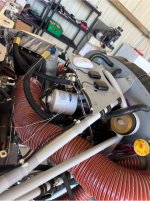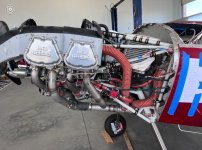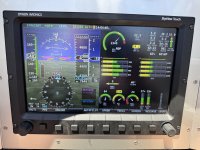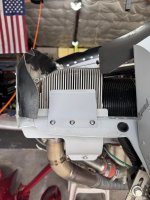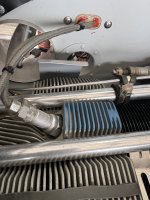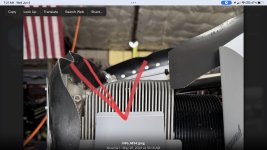Xkuzme1
Well Known Member
Hey y’all.
Historically I’ve asked more questions than I’ve answered. So in an effort to be less of a non-contributing-zero, I thought I’d post about my efforts to lower my CHT#3 temps and Oil temps.
F-4 Raider
Lycon IO-360A1B6 220hp
Right now she has just a shade above 5 hours on it. So my temps are still a little high from break in. At about 4 hours nearly all my CHTs dropped 15-20% so I’m assuming that the rings have started to settle in.
My oil cooler is attached to the motor mount behind cyl 4 and air is captured off of the baffling behind cyl 3. Air was routed using a 4 inch scat tube.
Cyl 2+4 chts and egts were nearly identical. No excessive heat, exactly where I’d like to see them.
Oil temps have been as high as 225, but normally we’re 210-215. Cyl#1 typically runs 50° cooler than #3. Cyl#3 with the power pulled back and full rich, is typically 390-410° but at full power I’ve seen it spike quickly past 415°.
I know it is still early to worry about temps with only 5 hours on the engine, but being proactive, I know that a 50° spread and the abnormally high oil temps should be addressed.
What I’ve done so far:
-I’ve put an angled air damn in front of Cyl#1
- washer mod done on both sides and bump (metal formed) behind cyl 3
-RTVd all gaps to promote positive airflow over fins.
-installed an air diverter Behind cyl #3 to make sure air is directed over the cylinder (and not get robbed by the oil cooler or heater box)
-replaced the 4” SCAT with 4” SCEET to try to remove some turbulence inside journey from the air source to the oil cooler.
I know my oil cooler placement is not optimum. But honestly I’m only a little hot. If I could reduce oil temps by 10-15° and even out my CHTs on the right hand side, I’m a happy guy.
My nuclear option is to completely move the oil cooler and reduce the duct size. As of yet, I don’t see a reason to go nuclear.
Thanks for listening to my Ted Talk.
X
Historically I’ve asked more questions than I’ve answered. So in an effort to be less of a non-contributing-zero, I thought I’d post about my efforts to lower my CHT#3 temps and Oil temps.
F-4 Raider
Lycon IO-360A1B6 220hp
Right now she has just a shade above 5 hours on it. So my temps are still a little high from break in. At about 4 hours nearly all my CHTs dropped 15-20% so I’m assuming that the rings have started to settle in.
My oil cooler is attached to the motor mount behind cyl 4 and air is captured off of the baffling behind cyl 3. Air was routed using a 4 inch scat tube.
Cyl 2+4 chts and egts were nearly identical. No excessive heat, exactly where I’d like to see them.
Oil temps have been as high as 225, but normally we’re 210-215. Cyl#1 typically runs 50° cooler than #3. Cyl#3 with the power pulled back and full rich, is typically 390-410° but at full power I’ve seen it spike quickly past 415°.
I know it is still early to worry about temps with only 5 hours on the engine, but being proactive, I know that a 50° spread and the abnormally high oil temps should be addressed.
What I’ve done so far:
-I’ve put an angled air damn in front of Cyl#1
- washer mod done on both sides and bump (metal formed) behind cyl 3
-RTVd all gaps to promote positive airflow over fins.
-installed an air diverter Behind cyl #3 to make sure air is directed over the cylinder (and not get robbed by the oil cooler or heater box)
-replaced the 4” SCAT with 4” SCEET to try to remove some turbulence inside journey from the air source to the oil cooler.
I know my oil cooler placement is not optimum. But honestly I’m only a little hot. If I could reduce oil temps by 10-15° and even out my CHTs on the right hand side, I’m a happy guy.
My nuclear option is to completely move the oil cooler and reduce the duct size. As of yet, I don’t see a reason to go nuclear.
Thanks for listening to my Ted Talk.
X



